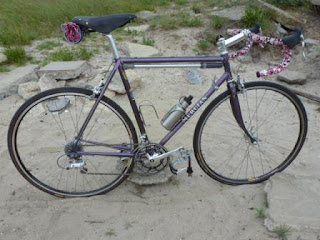How do you know you're in Hipster Hook?
Well, first of all, I should tell you where and what Hipster Hook are.
Roughly, HH rims the East River in Brooklyn and Queens from the Williamsburgh Bridge to the Queensborough (a.k.a. 59th Street) Bridge. From the river, it stretches a few blocks inland, to about Driggs Avenue in Brooklyn and 11th Street in Queens. Hipster Hook includes parts of the Brooklyn neighborhoods of Williamsburgh and Greenpoint, and the Queens Community of Long Island City.
All right. You don't always have your map or GPS handy. So, how else can you tell you're in the Hook?
Well, just take a look at the bikes parked locked to the sign posts, parking meters or other immobile objects:
I mean, where else are you going to find a '70's Bob Jackson, with a full set of Campagnolo Nuovo Record Components, converted to flat-bar use and locked up next to two other bikes?
If you've been following this blog, you have probably realized that I favor purple and deep green (especially British Racing Green), cobalt blue or burgundy bikes. But I also have a soft spot for orange bikes of that time. (I include Marianela, the Schwinn Le Tour I used to ride.) Somehow, the orange bikes made since then just don't have the same kind of character: Instead of glowing, they shout.
Anyway, I think that bike also has the only thing that, to me, could have made it even prettier: a somewhat-aged Brooks B-17 saddle in honey.
I wish I could have gotten a full solo shot of the bike. Oh well. At least one of the bikes locked next to it was a Masi from the same era. Today, bikes bearing the Masi name are being made in Taiwan and seem to be, at best, parodies of the real thing.
And how else do you know you're in Hipster Hook? Well, the bike locked next to the Bob Jackson and Masi was a current KHS bike. Not bad, really: I once had a KHS myself. But you simply can't compare it to those other two bikes!
Well, first of all, I should tell you where and what Hipster Hook are.
Roughly, HH rims the East River in Brooklyn and Queens from the Williamsburgh Bridge to the Queensborough (a.k.a. 59th Street) Bridge. From the river, it stretches a few blocks inland, to about Driggs Avenue in Brooklyn and 11th Street in Queens. Hipster Hook includes parts of the Brooklyn neighborhoods of Williamsburgh and Greenpoint, and the Queens Community of Long Island City.
All right. You don't always have your map or GPS handy. So, how else can you tell you're in the Hook?
Well, just take a look at the bikes parked locked to the sign posts, parking meters or other immobile objects:
I mean, where else are you going to find a '70's Bob Jackson, with a full set of Campagnolo Nuovo Record Components, converted to flat-bar use and locked up next to two other bikes?
If you've been following this blog, you have probably realized that I favor purple and deep green (especially British Racing Green), cobalt blue or burgundy bikes. But I also have a soft spot for orange bikes of that time. (I include Marianela, the Schwinn Le Tour I used to ride.) Somehow, the orange bikes made since then just don't have the same kind of character: Instead of glowing, they shout.
Anyway, I think that bike also has the only thing that, to me, could have made it even prettier: a somewhat-aged Brooks B-17 saddle in honey.
I wish I could have gotten a full solo shot of the bike. Oh well. At least one of the bikes locked next to it was a Masi from the same era. Today, bikes bearing the Masi name are being made in Taiwan and seem to be, at best, parodies of the real thing.
And how else do you know you're in Hipster Hook? Well, the bike locked next to the Bob Jackson and Masi was a current KHS bike. Not bad, really: I once had a KHS myself. But you simply can't compare it to those other two bikes!
















.jpg)


